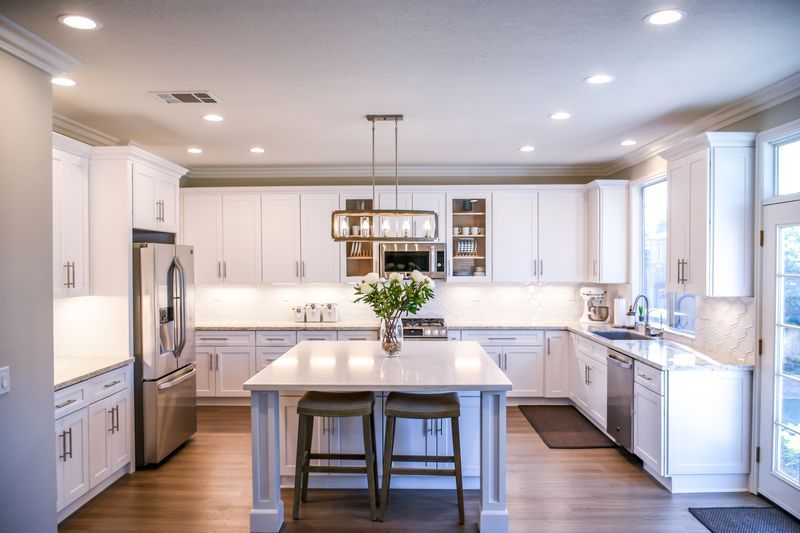Smart Light Bulb VS Smart Switch
The Pros and Cons of Smart Light Bulb VS Smart Switch

Technology has come a long way since the original Clapper impressed TV viewers with the luxury of turning off the lights with a simple clap, all the while when you’re still in bed. Now there’s mechanics to dim the lights, control the colors and settings, set timers and schedules, all with your smartphone or voice command.
Installing smart lights is often the first step to home automation. The ease and convenience makes the switch a no brainer. If your hands are full of groceries, or the light switch is in a hard to reach place, the convenience of having lights turn on as your enter the room, is something we all could use and enjoy. Once it’s set up, it’s very simple to activate. And you will never want to go back to the days of fumbling to reach for the switch again.
There are lots of options when it comes to installing smart lights. We’re here to guide you through all the factors that differentiate smart light systems - from cost, to convenience, compatibility, and functionality. Let us help you determine the best setup for your home’s needs.
Benefits of Smart Bulbs
A smart light bulb is an LED light bulb that has Wi-Fi capability - enabling endless customization, scheduled operation, and remote control options. You can connect it to an app to control the brightness or color. With simple set up
A Stunning Light System
Are you sick and tired of your yellow incandescent lights making you feel dull and tired? Or what about the harsh glare of bright fluorescent lights that negatively impact productivity, mood, mental and physical fatigue, and even reduces focus and alertness? Did you know that light has the power to have such a big impact on your well being and influence your mood? Do not underestimate the power of light.
Now imagine being able to control the color and brightness of your lights, and thereby positively influencing your mood and health.
Smart bulbs can add a great ambience to any room. Each bulb can be set at any color and create beautiful effects. Some brands like the Philips Hue, come with pre-made light scenes that are captivating. Savannah Sunset and Arctic Aurora are crowd favorites.
There are even some smart bulbs on the market that enable you to sync color and lighting changes to the beat of your music or dialogue in a movie.
There is certainly a fun side to utilizing smart light bulbs. The possibilities to add a colorful dimension to each room is endless. For your enjoyment or to showcase your home to friends and guests, installing smart bulbs is a sure way to create a more welcoming and calm atmosphere that will please any crowd.
Energy Efficient and Cost Efficient
A typical smart bulb will last an average of 20,000 hours. Some can last even up to 30,000 hours, which is an incredibly long life span compared to traditional bulbs. We’re talking upwards to 28 years of light from a single smart bulb. That means you’ll replace it once or twice in your lifetime.
Smart bulbs are energy efficient because they use LED technology, which not only uses less electricity, but it is resistant to extreme temperatures.
Easy to Install Smart Light Bulbs
They are simple to install, just the way you would change a regular light bulb - Unscrew to remove and add the new one.
The modifications and usage isn’t too complicated, but may get technical for the beginner user. It would benefit to hire a professional to get the most out of your smart home light system.
Multifunctional features of Smart Bulbs
Smart light costs are fairly priced, but you can also spend a little more and find endless features that track motion, change colors, stream audio, or even multi-function as a camera. How cool is that?
Smart bulbs can even be programmed to adjust the color temperature throughout the day, depending on what time it is. It offers an easily customizable smart light system that suits your schedule and other needs.
Downsides of Smart Bulbs
There are a few downsides to installing smart bulbs that you should consider. The two main issues are cost and incompatibility. Let’s take a deeper look at whether the disadvantages of smart bulbs are big enough concerns for your needs.
Smart Bulbs are More Costly than Smart Switches
Installing smart bulbs will cost more than installing one smart switch that can light up the entire circuit. Cost will vary and depend on the quantity of bulbs you’ll need and the quality of lights you’ll want. But on average, they are on the higher side and can cost anywhere from $8-$60 dollars per bulb, depending on the colors and functions you need.
Smart bulbs will use more energy to operate when compared to a smart switch. That’s because they must always be powered on. These bulbs are categorized as Vampire Devices, which uses electricity even though they are not turned on. Smart bulbs need a constant connection to Wi-Fi or Bluetooth. This only amounts to a few extra cents per bulb, per month. Depending on the quality of the smart bulb, multiple units around the house will add a few extra dollars to your electricity bill. Even if it’s minimal, if energy cost is a concern, smart switches will be a better choice.
Smart Bulbs are Incompatible with Some Light Fixtures
Unfortunately, not every light fixture will enable a smart light bulb to be installed. Those that use smaller than standard bulbs will be incompatible with the single size of smart bulbs. They will need to be the standard A-shape in order to work with smart light bulbs. Fixtures may even require a series of LED strips, rather than bulbs.
Smart light bulbs are also not compatible with switches and dimmers. Attempting to use them together may damage the internal components.
Smart Bulbs can get Technically Challenging
There will be occasional software updates or glitches where you’ll need to troubleshoot and reconnect the smart light bulb to the app. Some manufacturers also require a smart plug or connector to your router, which can get bothersome. Pairing and controlling the bulb and plug can be difficult for some users, and it would benefit to receive the help of a professional to troubleshoot and fix when needed.
Benefits of Smart Switches
A smart switch is basically a light switch that is controlled remotely. It has the ability to control all the light sources in its circuit. It can automatically turn on/off, program scheduled automation,
And offer 24/7 monitoring and access to your devices. They are energy efficient, easily compatible with any fixture, and certainly convenient.
Smart Switches are Energy Efficient
A smart switch can be an efficient option in certain situations where the light fixture requires multiple light bulbs. Instead of replacing each bulb with a smart light bulb, you can simply install a smart switch to activate all bulbs in the circuit. So for example, if you have a fixture that requires 5 bulbs, you can either buy five smart bulbs, or one smart switch. If you don’t particularly need colored lights, a smart switch often makes sense.
Energy Efficient Means Cost Efficient
The average smart switch costs less than $20. One switch has the ability to control the entire room. The lifespan of a smart switch is also longer than smart bulbs, making its cost even lower.
Smart Switches are Compatible With Many Light Fixtures
Smart bulbs, fluorescent lights, incandescent bulbs, floodlights, chandelier bulbs, ceiling fan bulbs, dimmable switches, and many more - you name it, smart switches are compatible with most kinds of bulbs of different types and sizes.
Smart Switches are Convenient and Efficient
Smart switches can be very efficient and convenient to use. There are more programmable features to automate the devices that a smart switch is connected to.
Installing a smart switch certainly provides a convenient way to automate and control your devices remotely. You can even use it with an app that can be used away from home. The best smart switch connects with devices like Google Home, Amazon Alexa, Siri, Google Assistant, and other smart switch phone apps. If you are familiar with these apps, you’re aware of the added advantage of voice control.
Beyond the basic light switch automation, a smart switch comes with other cool features like scheduling and remote access to your devices. You can program your smart switch to turn on and off at certain times of the day. And you can access controls from anywhere, anytime.
Downsides to Smart Switches
Challenge to Install a Smart Switch
Smart switch installation will be more challenging than just screwing in a light bulb. It will require you to remove and replace the old switch from the wall. You’ll need tools and basic knowledge of working with electrical wires. The process can be invasive, but it’s necessary to connect the live and load wires together in order for the lights to always receive power.
Furthermore, if you want to change the smart switch to a different light fixture, you’ll have to repeat the installation process all over again.
So which is better? A Smart Bulb or Smart Switch?
The answer depends on your needs and what features you find attractive and more convenient. Smart bulbs offer a wide range of color-changing, dimming, as well as automation. Some smart light bulbs even allow the user to control the bulb with an app. It can be user friendly, but there is a learning curve as the compatibility and user features can be confusing and inconvenient, especially when used with a hard wall switch.
A smart bulb uses a lot less electricity than traditional light bulbs, but a smart switch is even more energy efficient, and thereby cost efficient. Smart light switches are compatible with multiple light bulbs and offer even more options for efficiency. They can easily be paired with Alexa, Siri, or Google Home, which makes it a family friendly option.
Both options will give you ease of use and convenience beyond your imagination. With smart bulbs, you will get the added benefit of creating the right ambience for any room, mood, or event.
Whichever smart light device you choose, you should consult with your smart home installer to guide you through all the different options available on the market, as well as covering safety protocols regarding the installation process.
Installing a smart light for one room might not be too difficult. But effectively and strategically automating your whole house with smart lighting could use the help of a professional. Some rooms may benefit from using smart bulbs, and in other cases, it might make more sense to utilize a smart switch to power on the whole light circuit. In most cases, you cannot use both a smart bulb and smart switch together. A smart light needs to always be powered on, but this is not viable when the smart switch is turned off. Once the power is cut off, the smart bulb disconnects from your smart home.
There is common fix to this issue for integrating smart light bulbs with smart switches. Something like the Philips Hue dimmer switch will accomplish this and using it in connection with a Hue hub will achieve optimal functionality and results. There can be an overwhelming number of options to consider when shopping for a smart light system.
Ultimately, everything will depend on your budget, convenience, and compatibility. Allow us to help guide you through the design, installation, and implementation of all the features a smart light system can do for your home.
Contact us today for your free consultation and estimate of a smart home lighting system.
Leave a Reply
Your email address will not be published. Required fields are marked *

